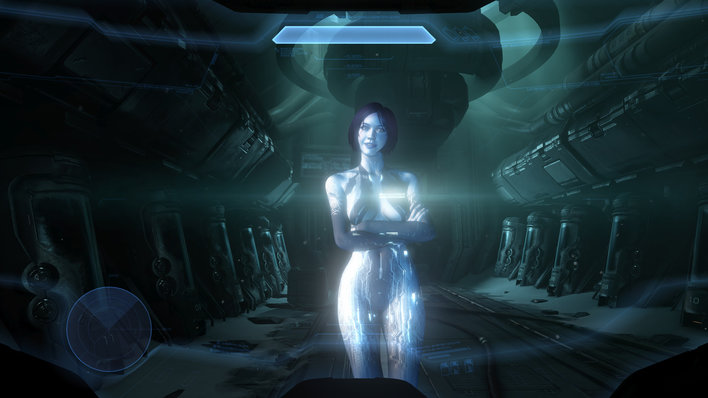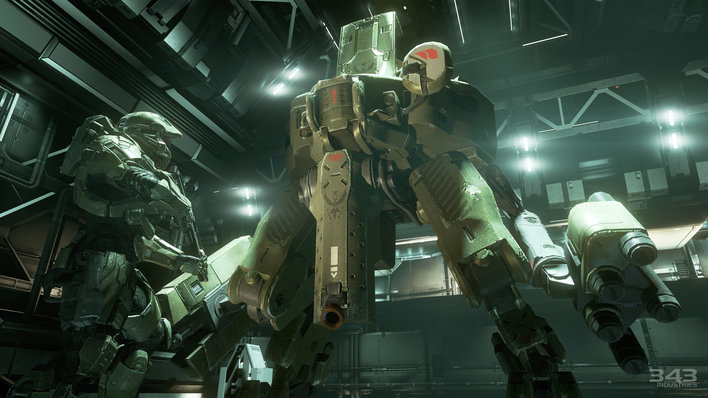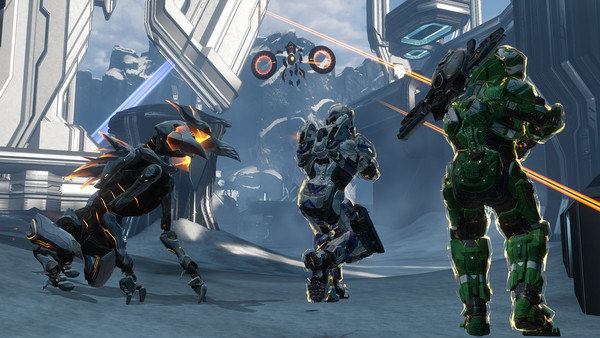A large part of the reason why blockbuster films because so popular is because, most often, no matter how complex their story may be, it can always be distilled into a sentence or two. They don't require any prerequisite knowledge of the film in question, of the universe, or even of the film itself - you can turn up cold, walk into a cinema, and enjoy a good film. Despite the giant galactic war and bastard children (Luke, not Anakin), Star Wars was still a story of good versus evil, Darth versus Luke, that anyone could follow. Even the Matrix, with its sub-plots and conspiracies galore, was still understandable - and that had a story about as complex as they come. But Halo? Were it so easy.
Like the games that came before it, Halo 4 is a sci-fi themed first person shooter that puts you into the space boots of Master Chief, our green armoured protagonist who was (at least formerly) the last remaining Spartan - a genetically modified super-soldier and all round hero that acted as humanity's defenders. At the end of the last game [HALO 3 SPOILERS] poor old Master Chief ended up being dragged through a wormhole of sorts, finding himself trapped, millions of light years away from home. Missing presumed dead, and without much hope of a passer by coming across him any time soon, Chief puts himself into stasis, and leaves his holographic AI companion, Cortana, to keep watch. "Wake me when you need me" [/HALO 3 SPOILERS]

Well, she seems cheery enough.
As if by magic, "when you need me" happens to coincide with the start of Halo 4, when the ship the Chief is held in stasis in (or what remains of it) is boarded by the Covenant, a coalition of sorts of intergalactic religious nutters, who've been your foils for the previous few games. Within the space of a few levels, you'll discover you've ended up in front of a forerunner planet, there's a guy called the Didact who flies around in some sort of personal Death Star, and a librarian who wants to talk to you about humanity's "ascension", a mantle, and a "composer", which is going to somehow end the human race, despite the Didact apparently using it in the past to save all life in the galaxy but end the humans, and something about blurring the digital and biological realms, and your personal evolution. Phew.
If you're a little bit confused now, you're not the only one - and that's the most disappointing thing about Halo 4. Much like Reach that came before it, if you want to follow the story here, you'll have to have graduated as Professor of Halo from the Halo department at the UNSC university, as without an incredibly in depth knowledge of the series, its characters, and universe that goes even beyond the games, playing Halo 4 will be like hitting your head against a plasma wall. If you haven't read every graphic novel, studied every book, and if you don't spend your day alternating between halowaypoint.com and the Xbox 360 app of the same name, the story will likely be almost completely impenetrable to you. All of which is really disappointing, because under the surface, they have a story here that anyone can connect with - it's just buried under needlessly complex details.
You see, having been in stasis, Master Chief has worn the years pretty well - but sadly, the same isn't true for his AI companion, Cortana. Near the start of the game, as she starts to break up mid-sentence, lose her train of thought, and crackles, she nervously explains the problem - "I was put into service eight years ago. AIs deteriorate after 7". And that's what should be at the centre of the story. Your AI, your friend, Cortana is going through the AI equivalent of dying - and it's up to you to save her. If you can find a woman named Dr Halsey, you may be able to save your companion of past four game's life - but you're trapped on a planet with no way to escape, and no easy way to locate the doctor.

Challenge accepted
Much like the games that came before it, Halo 4 is fully playable in split-screen co-op, both through the story, and online - although sadly, only two players can play through the story on the same console. Great for families, partners and friends who want to play together - and great for you, because you get a helping hand - the co-op has always been the highlight of the Halo experience. Whether you're finding your way around the brushed gun-metal corridors of a spaceship, or exploring the surface of a monolithic planet, everything's a lot more fun with a second player in tow. It's easier, too - which is lucky, because Halo 4 is noticeably harder than the games that came before it.
Despite the fact you're some sort of genetic super-hero, Chief is a lot weaker than he was in previous games. While he still has a shield (which recharges when you aren't taking damage), you'll find you can't absorb quite as much punishment as you used to. When faced with a particularly large group of Covenant, more often than not, you'll end up having to run, hide, and pick enemies off from a distance, which kind of takes some of the shine off being a super hero.
Luckily for you, if you're playing in two player co-op, dying doesn't matter quite as much as it would if you were on your own. Should you happen to be killed in co-op, instead of being reset to the last checkpoint you passed, you'll instead be able to respawn next to your co-op partner - so long as they can stay alive, and find a relatively safe space. And with so many different types of enemies, all vying for the same thing, you'll be appreciative of the help.
The enemies you'll come across on Halo are as varied as they are numerous. Coming at you in groups, each "type" has their own personality, skills, and abilities, that makes taking on a group a challenge indeed. On the Covenant side of things, the majority of the forces you'll come across are the strange badger-wearing-a-gas-mask-alike grunts, who're short, a bit useless, easily spooked, and are quick to scarper at the first sign of losing a battle. Things get a little bit more interesting when you come across the jackals, whose giant energy shields make them harder to hit, and predisposes them to preferring to snipe at you from a distance. The "generals" of the Covenant forces are the Elites, which bare a passing resemblance to the Aliens from the Ridley Scott films, and also have a bodyshield, like Master Chief, letting them absorb a fair amount of ammo before they even start to take damage, while the tanks of the Covenant, Hunters, whose thick armour leaves only a few points on their body vulnerable to your fire, are thankfully few and far between - which is a relief, as they're so tricky to take down.

The Prometheans don't have the same impact the Covenant have.
New for this game (but again, where they've come from is pretty poorly explained) are a group known as the Prometheans, who have fewer, less specialised variations, but can still pose a challenge. Promethean Knights are the Elite equivalents - large, intelligent, and with a bodyshield, while Crawlers are weird, four-legged creatures that carry guns in their mouths (see above left). The worst the Prometheans have to offer, though, is the Promethean watchers, which fly around, resurrecting fallen comrades - and making your job a heck of a lot harder.
It's at times like this you'll be especially thankfully for your co-op buddy, who can lend you an extra gun for the biggest battles, and, if nothing else, can at least serve as a distraction for enemies - but it's not only on foot that your co-op partner comes in handy. A large part of Halo, and indeed Halo 4, is a focus on vehicles, and the latest game doesn't disappoint. From the second mission, which drops you into the oddly-named Warthog (an armoured jeep that seats three people, with one riding shotgun, and another in the back on a minigun turret), the vehicle sections regularly punctuate the action, from hovering around the landscape in a Ghost, to taking to the skies in a Banshee.
Unfortunately, though, the vehicle sections aren't always the highlight you'd imagine, no matter how much fun they might sound. In fact, the two sections that rely exclusively on vehicles have been rather poorly put together - especially when you're playing in split-screen co-op. One sees you riding a Ghost, speeding through tunnels as they start to cave in, darting through the already narrow gaps as they close in in front of you.
The problem is, in two player, it all starts to feel a bit rough around edges. Forcing you into a tricky predicament, you're forced to stay together - as if one player gets too far behind, they'll be crushed by the tunnel collapse - but if you try to stick together, you'll end up crashing into each other, and flipping each other over, leading you both to a sticky end. Only one of you has to survive, of course, so it's entirely possible for one player to just sit the section out - but that's not really the point of playing in co-op. The other vehicle-driven section comes courtesy of the very last level, and again, when playing in co-op - especially when playing in split-screen - it isn't very good [if you don't want minor spoilers about what's involved in the last level, it's probably best to skip this paragraph]. Forcing you to play in a tiny window as it does, you're asked to perform your own version of the Death Star trench run, flying a ship down a narrow corridor - only this time, you're up against a corridor that fights back. Shifting, and changing as you attempt to navigate it, you're forced to dodge not only the moving walls and floors, but countless thin rods that dangle down from the ceiling. When playing in split-screen, thanks to the tiny window you end up playing in, the rods become so thin, it's tricky to judge where they are, leading to one too many unfair deaths.

Some of your computer controlled "friends" aren't all that helpful, either. To get past certain sections in this level, you'll have to jump on board that giant monstrosity - but with the driver being unwilling to stop, you'll often find yourself getting left behind.
In fact, the way co-op's handled in general in Halo 4 is surprisingly poor. Gone is the lovely, using-all-the-screen wonder of Halo Anniversary, as you're instead forced to play in a letterbox window, with large black boxes down either side. Even a few feet away from a 32" TV, it can be tricky to see things - and with so much extra space available, it's frustrating the developers haven't made use of it. Worse still though, is that certain sections seemingly just haven't been all that well tested in split-screen co-op. On several occasions, we got locked on two separate sides of a door, and had to wait until a checkpoint to respawn in the right place - but the worst incident has to be on the fourth level, which sees an enemy drop a power-up known as "reaper vision". Turning your vision into a sort of an infra-red visor, which highlights enemies, it's a power-up you need to pick up in order to get through the next section, which sees you having to navigate a valley, swarming with enemies, in thick fog. Unfortunately for you, when playing in co-op, there's only a single power-up available - so only one player can actually see where they're going, leaving the other to blindly feel their way through. Worse still, in our case, the player who picked the power up then promptly died, which took the power-up off him, leaving both of us blindly hoping we'd find our way through to the other side. It's a certainly a bit of an oversight - as is the fact that certain cutscenes - even the intro/pre-intro to the game - don't actually play when you have a second profile logged in.
As you progress through the game, it'd be nice to say the pieces of the story eventually start to come together, but in Halo 4, they really don't. If anything, the more you play, and the more you learn, the more confused you'll be. It doesn't help that the developers have seen fit to pepper the game with military jargon and invented sci-fi terms, without ever explaining what they mean. Near the beginning of the game, Cortana explains she's suffering from "rampancy", but doesn't define the term until three or four levels later. In another level, she makes reference to a soldier's IFF tags, which the Chief has to go and collect. Their what? Even a quick Google search doesn't help - the first result suggests it could be their International Flavours and Fragrances tag, but we doubt you can identify a soldier from their smell; while another suggests it might be a Cardiff bus card. At least you'd know where the soldier came from, then. Other phrases continue to confuse, or at least, obfuscate. "Weapons free" - well, we didn't expect to have to pay for them. "Significant EOF next to the emplacements" We can't even begin to guess what that means. When you're having to keep track of several races, weapons, characters, and pieces of sci-fi technology, none of which are ever properly defined and explained, it all just serves to make an already grey situation even greyer.
With the main storyline weighing in at just over five hours, this is also one of the shortest games you'll play this year. While the press in the build up to the game actually seemed impressed by the fact it has an "eight mission campaign", eight missions, to us at least, sounds more than a tad on the short side. We remember the time when first person shooters came with thirty missions, and lasted at least twice as long as they do now. They may not have looked as fancy, but you certainly got more bang for your buck.
However, the ace up Halo's sleeve, and the thing that stops you being able to finish it over the course of a couple of evenings, is easily its "extra campaign", Spartan Ops. A free, episodic series of ten "episodes", which are unlocked on a weekly basis, the Spartan Ops missions form a second campaign of sorts, with shorter, more objective oriented missions, and a loose story that follows the adventures of two groups of Spartans (again, it's not explained where these Spartans have come from, seeing as you're meant to be the last one), which intertwine with the Master Chief's adventures in the main game. Designed to be played through co-operatively with a group of friends, the missions can nonetheless be played on your own, and are a lot of fun. Boiled down into bite-sized, 15 minute chunks, and with five missions per-episode, the Spartan Ops missions are a great addition to the game, that'll keep you coming back at least until Christmas - even if we would have preferred that the effort had gone into extending the main campaign, rather than giving us a separate story to play through. It's worth bearing in mind, too, that you'll require an Xbox Live Gold Account in order to be able the Spartan Ops campaign. From what we can see, there's no real reason why this should be the case - the entire campaign's downloaded when you first boot up the game (or installed off the second disc), so we can only imagine that the Live requirement is working kind of like an online pass, by requiring you to subscribe to Xbox Live Gold in order to play half the game you've paid for - and should your Gold subscription lapse, you'll be locked out again.
With Halo 4 marking both passing of the development reigns from one studio to another, and the kick off an all new trilogy (which we can only assume will continue on the next Xbox console, expected to be announced in May next year), Halo 4 certainly had a heavy task on its hands - and it may have set its sights too high. Having to tie together the loose ends of the first game, whilst conjuring up an all new storyline that'll carry the series forward, Halo 4 has sadly fallen short of what it set out to achieve. With an obtuse storyline, buried beneath military jargon and poorly explained sci-fi, Halo 4 feels less like the beginning of a new trilogy, and more like the end of the first - a trilogy in four parts. While the gameplay underneath, at times, is every bit as good as it used to be, some awkward bugs that pop up in split-screen co-op, the fact you're still forced to play in a tiny window, and the way you actively seem to be punished for playing in split-screen with a friend, all serve to drag the overall Halo experience down. It's certainly a long way from awful, but it's not up to the usual Halo standards either. If you don't have your Xbox 360 connected to the internet, we'd certainly think twice before picking this up - but if you have a Gold subscription, and prefer co-op to competitive multiplayer, it's certainly worth considering. Either way, with a new trilogy kicking off, it'll be interesting to see where Halo goes from here.
Format Reviewed: Xbox 360




















